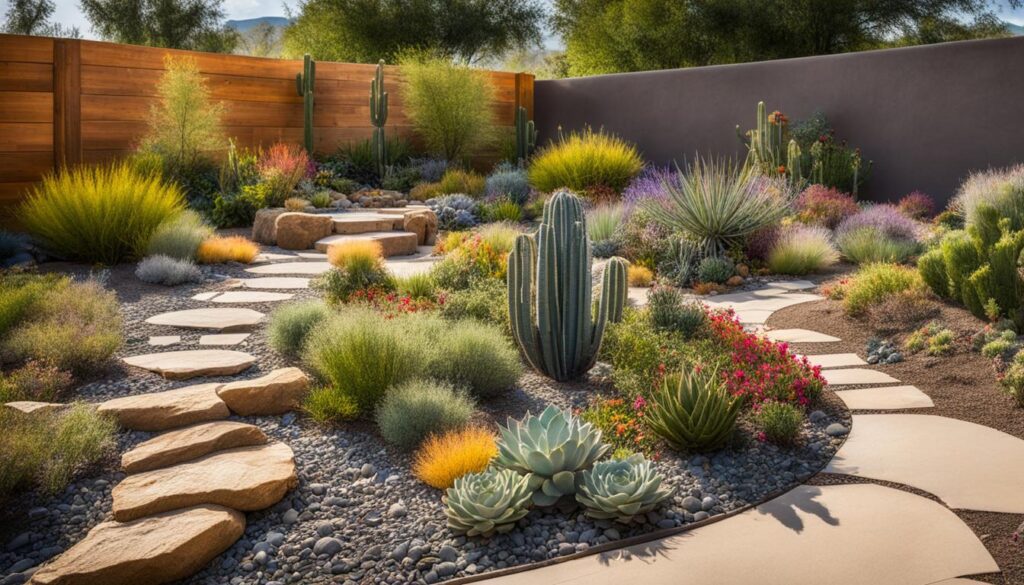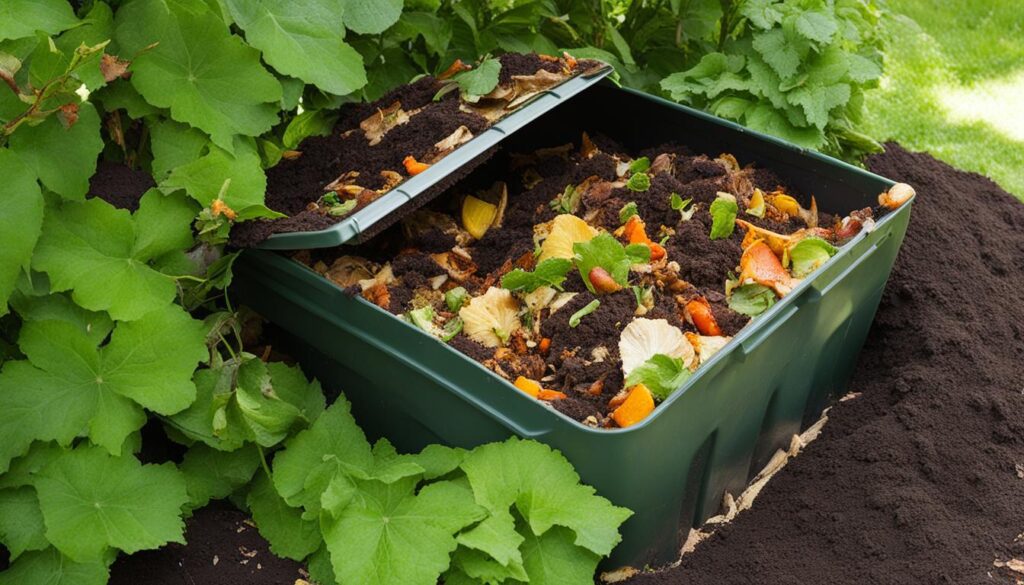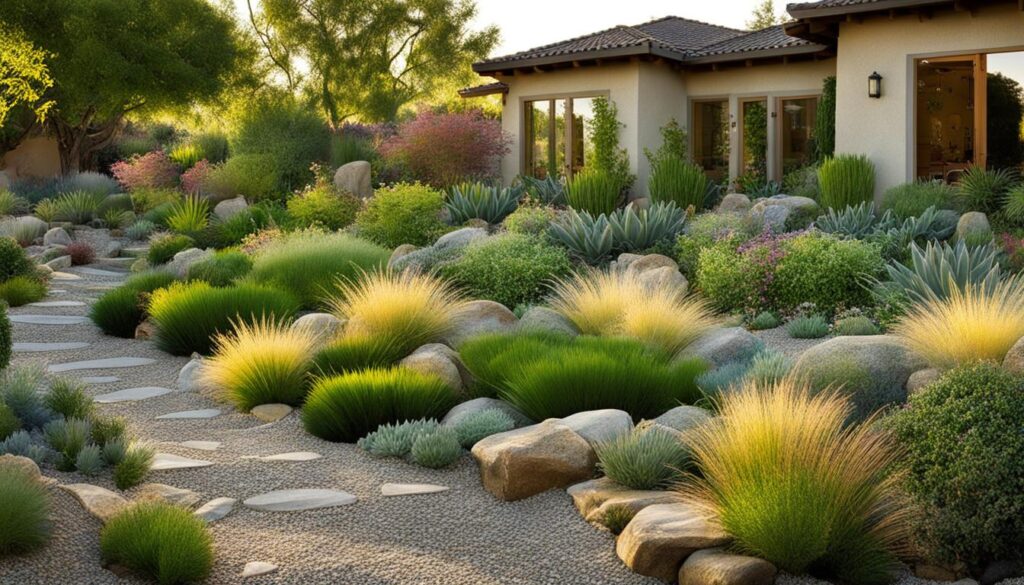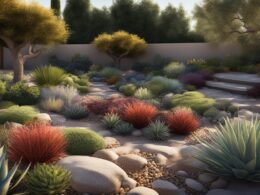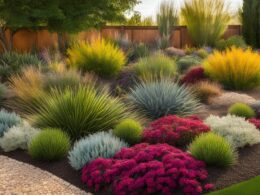Transforming your backyard into a sustainable oasis is a rewarding project that allows you to connect with nature while being environmentally conscious. By implementing DIY sustainable xeriscape garden plans, you can create a beautiful and low-maintenance space that conserves water and attracts native wildlife.
With a backyard oasis, you can escape the hustle and bustle of everyday life and create a serene environment right at your doorstep. Imagine stepping outside and being greeted by a vibrant and eco-friendly haven that encourages relaxation and mindfulness.
With an eco-conscious mind, you can design a garden that not only enhances the beauty of your backyard but also supports the surrounding ecosystem. By incorporating sustainable practices and utilizing native plants, you can make a positive impact on the environment.
In this article, we will explore the importance of using native plants, composting and rainwater harvesting, upgrading existing features, and decorating with recycled or sustainable materials. Whether you have a small patio or a sprawling yard, these DIY sustainable xeriscape garden plans will inspire you to create your own oasis.
Key Takeaways:
- Implementing DIY sustainable xeriscape garden plans allows you to create a beautiful and low-maintenance oasis in your backyard.
- Using native plants in your garden is essential for sustainability and attracting local wildlife.
- Composting and rainwater harvesting are eco-friendly practices that conserve water and promote healthy soil.
- Upgrading existing features with energy-saving tools and sustainable materials reduces the environmental impact of your outdoor spaces.
- By creating a sustainable garden, you can save water, reduce maintenance, and support local biodiversity.
Incorporate Native Plants for an Eco-Friendly Landscape
If you’re looking to create a sustainable garden, incorporating native plants is a crucial step. Native plants are perfectly adapted to your region’s climate, making them resilient and low-maintenance. By choosing native species for your xeriscape garden, you can reduce water consumption and create an eco-friendly landscape.
Native plants have evolved alongside local wildlife, making them an excellent choice for attracting pollinators such as bees and butterflies. These pollinators play a crucial role in plant reproduction and the overall health of the ecosystem. By providing them with a habitat rich in native plants, you can support biodiversity and contribute to the preservation of local wildlife.
When selecting native plants, consider their water requirements and growth habits. Choose species that are well-suited to your region’s natural rainfall patterns and soil conditions. This will help minimize the need for supplemental watering and ensure that your plants thrive in their environment. Additionally, grouping plants with similar water needs together can further optimize water usage and promote efficient irrigation.
Benefits of Incorporating Native Plants:
- Reduced water consumption
- Low-maintenance landscaping
- Support for local wildlife and pollinators
- Enhanced biodiversity
- Increased resilience to climate conditions
By incorporating native plants into your xeriscape garden, you not only create a visually appealing landscape but also contribute to the preservation of your local environment. It’s a win-win situation for both you and nature.
Quick Tips for Incorporating Native Plants:
- Research your region’s native plant species
- Choose plants that are well-adapted to your climate
- Consider the water requirements and growth habits of each plant
- Create diversity in your plant selection to support various wildlife species
- Group plants with similar water needs together for efficient irrigation
Harness the Power of Composting and Rainwater Harvesting
In your quest to create a sustainable garden, harnessing the power of composting and rainwater harvesting can significantly contribute to your eco-friendly efforts. Composting is a simple and effective way to reduce waste while producing nutrient-rich fertilizer for your plants. By composting your kitchen scraps, yard waste, and other organic materials, you can divert them from landfills and create a sustainable cycle of nutrient replenishment for your garden. Additionally, composting helps improve soil structure, water retention, and overall plant health, making it a vital practice for sustainable gardening.
Composting Tips:
- Use a compost bin or pile to contain and manage the composting process.
- Balance the ratio of green (nitrogen-rich) and brown (carbon-rich) materials for optimal decomposition.
- Aerate and turn the compost regularly to enhance decomposition and prevent odors.
- Avoid adding meat, dairy, or oily food scraps, as they can attract pests.
- Monitor the moisture levels and add water or dry materials as needed to maintain a damp but not waterlogged compost pile.
Rainwater harvesting is another sustainable practice that can minimize water usage in your garden. By collecting rainwater and using it for irrigation, you can reduce your reliance on treated water while conserving this precious resource. Rain barrels, downspout diverters, or even larger-scale systems like bioswales or grading can help you capture and store rainwater efficiently. Using rainwater for your plants not only saves money on water bills but also ensures a more natural and balanced hydration for your garden. Plus, rainwater is often free of the chemicals found in tap water, making it healthier for your plants.
Rainwater Harvesting Tips:
- Choose a rain barrel or storage system suitable for your garden’s needs and available space.
- Position the barrel beneath a downspout or gutter to catch the maximum amount of rainfall.
- Install a filter or mesh screen to prevent debris from entering the barrel.
- Consider adding a spigot or valve for easy access to the collected water.
- Ensure proper drainage and overflow mechanisms to prevent waterlogging or flooding.
By incorporating composting and rainwater harvesting into your sustainable gardening practices, you can reduce waste, conserve water, and nourish your plants naturally. These eco-friendly techniques not only benefit your garden but also contribute to a healthier and more sustainable environment.
How Can I Incorporate Rock Elements into My DIY Sustainable Xeriscape Garden?
Looking to create a sustainable xeriscape rock garden in your backyard? Our xeriscape rock garden tutorial will guide you on how to incorporate natural rock elements into your DIY garden. By carefully selecting native drought-resistant plants and arranging rocks strategically, you can create a beautiful and low-maintenance landscape.
Upgrade Your Existing Features for Sustainability
If you already have high-maintenance features like a lawn or swimming pool, there are ways to make them more sustainable. One option is to replace your traditional turfgrass with low-maintenance alternatives such as wildflowers, ornamental grasses, or shrubs. These alternatives not only reduce water consumption but also require less maintenance, saving you time and effort.
When it comes to your swimming pool, consider incorporating energy-saving tools to reduce your environmental impact. Installing efficient pool pumps and timers can significantly decrease energy usage. Additionally, using a solar cover can harness the power of solar energy to warm your pool and prevent water evaporation, further conserving resources.
“By implementing these upgrades, you can transform your existing features into sustainable elements of your outdoor space,” says Jane Smith, a sustainability expert. “These changes not only reduce your carbon footprint but also create a more eco-friendly environment for you and your family to enjoy.”
Another way to enhance the sustainability of your outdoor space is by using sustainable materials for decks, patios, and fences. Consider options such as bamboo, reclaimed materials, or natural stone. These materials not only have a lower environmental impact but also add a unique and natural touch to your backyard oasis.
By upgrading your existing features with low-maintenance alternatives, energy-saving tools, and sustainable materials, you can create a more eco-friendly outdoor space that aligns with your sustainable lifestyle.
Conclusion
Creating your own sustainable garden through DIY xeriscape techniques can provide you with a beautiful and environmentally friendly backyard oasis. By incorporating native plants, implementing composting and rainwater harvesting, upgrading existing features, and using recycled or sustainable materials, you can create a sustainable garden that not only saves water and reduces maintenance but also supports local biodiversity.
Utilizing native plants in your xeriscape garden is a crucial step towards sustainability. These plants are adapted to your region’s climate, require less water, and attract pollinators, contributing to local ecosystems. Composting and rainwater harvesting are sustainable practices that enhance your garden’s natural resource utilization. Composting reduces waste and creates nutrient-rich fertilizer, while rainwater harvesting conserves water for irrigation purposes.
Upgrading existing features such as lawns and pools can also make them more environmentally friendly. Replacing turfgrass with low-maintenance alternatives reduces water consumption, while energy-saving tools like efficient pool pumps and solar covers minimize energy usage. Additionally, utilizing sustainable materials like bamboo and reclaimed materials for outdoor structures reduces the environmental impact.
By incorporating these sustainable practices into your DIY xeriscape project, you can create an environmentally friendly backyard that promotes water conservation, reduces maintenance, and supports local biodiversity. Start transforming your backyard into a sustainable haven today and enjoy the beauty and benefits of an eco-conscious outdoor space.






